Rong Zhao
Physics-Driven Local-Whole Elastic Deformation Modeling for Point Cloud Representation Learning
May 20, 2025Abstract:Existing point cloud representation learning tend to learning the geometric distribution of objects through data-driven approaches, emphasizing structural features while overlooking the relationship between the local information and the whole structure. Local features reflect the fine-grained variations of an object, while the whole structure is determined by the interaction and combination of these local features, collectively defining the object's shape. In real-world, objects undergo elastic deformation under external forces, and this deformation gradually affects the whole structure through the propagation of forces from local regions, thereby altering the object's geometric properties. Inspired by this, we propose a physics-driven self-supervised learning method for point cloud representation, which captures the relationship between parts and the whole by constructing a local-whole force propagation mechanism. Specifically, we employ a dual-task encoder-decoder framework, integrating the geometric modeling capability of implicit fields with physics-driven elastic deformation. The encoder extracts features from the point cloud and its tetrahedral mesh representation, capturing both geometric and physical properties. These features are then fed into two decoders: one learns the whole geometric shape of the point cloud through an implicit field, while the other predicts local deformations using two specifically designed physics information loss functions, modeling the deformation relationship between local and whole shapes. Experimental results show that our method outperforms existing approaches in object classification, few-shot learning, and segmentation, demonstrating its effectiveness.
Quantitative evaluation of brain-inspired vision sensors in high-speed robotic perception
Apr 27, 2025Abstract:Perception systems in robotics encounter significant challenges in high-speed and dynamic conditions when relying on traditional cameras, where motion blur can compromise spatial feature integrity and task performance. Brain-inspired vision sensors (BVS) have recently gained attention as an alternative, offering high temporal resolution with reduced bandwidth and power requirements. Here, we present the first quantitative evaluation framework for two representative classes of BVSs in variable-speed robotic sensing, including event-based vision sensors (EVS) that detect asynchronous temporal contrasts, and the primitive-based sensor Tianmouc that employs a complementary mechanism to encode both spatiotemporal changes and intensity. A unified testing protocol is established, including crosssensor calibrations, standardized testing platforms, and quality metrics to address differences in data modality. From an imaging standpoint, we evaluate the effects of sensor non-idealities, such as motion-induced distortion, on the capture of structural information. For functional benchmarking, we examine task performance in corner detection and motion estimation under different rotational speeds. Results indicate that EVS performs well in highspeed, sparse scenarios and in modestly fast, complex scenes, but exhibits performance limitations in high-speed, cluttered settings due to pixel-level bandwidth variations and event rate saturation. In comparison, Tianmouc demonstrates consistent performance across sparse and complex scenarios at various speeds, supported by its global, precise, high-speed spatiotemporal gradient samplings. These findings offer valuable insights into the applicationdependent suitability of BVS technologies and support further advancement in this area.
Mapping at First Sense: A Lightweight Neural Network-Based Indoor Structures Prediction Method for Robot Autonomous Exploration
Apr 05, 2025Abstract:Autonomous exploration in unknown environments is a critical challenge in robotics, particularly for applications such as indoor navigation, search and rescue, and service robotics. Traditional exploration strategies, such as frontier-based methods, often struggle to efficiently utilize prior knowledge of structural regularities in indoor spaces. To address this limitation, we propose Mapping at First Sense, a lightweight neural network-based approach that predicts unobserved areas in local maps, thereby enhancing exploration efficiency. The core of our method, SenseMapNet, integrates convolutional and transformerbased architectures to infer occluded regions while maintaining computational efficiency for real-time deployment on resourceconstrained robots. Additionally, we introduce SenseMapDataset, a curated dataset constructed from KTH and HouseExpo environments, which facilitates training and evaluation of neural models for indoor exploration. Experimental results demonstrate that SenseMapNet achieves an SSIM (structural similarity) of 0.78, LPIPS (perceptual quality) of 0.68, and an FID (feature distribution alignment) of 239.79, outperforming conventional methods in map reconstruction quality. Compared to traditional frontier-based exploration, our method reduces exploration time by 46.5% (from 2335.56s to 1248.68s) while maintaining a high coverage rate (88%) and achieving a reconstruction accuracy of 88%. The proposed method represents a promising step toward efficient, learning-driven robotic exploration in structured environments.
SenseExpo: Efficient Autonomous Exploration with Prediction Information from Lightweight Neural Networks
Mar 20, 2025Abstract:This paper proposes SenseExpo, an efficient autonomous exploration framework based on a lightweight prediction network, which addresses the limitations of traditional methods in computational overhead and environmental generalization. By integrating Generative Adversarial Networks (GANs), Transformer, and Fast Fourier Convolution (FFC), we designed a lightweight prediction model with merely 709k parameters. Our smallest model achieves better performance on the KTH dataset than U-net (24.5M) and LaMa (51M), delivering PSNR 9.026 and SSIM 0.718, particularly representing a 38.7% PSNR improvement over the 51M-parameter LaMa model. Cross-domain testing demonstrates its strong generalization capability, with an FID score of 161.55 on the HouseExpo dataset, significantly outperforming comparable methods. Regarding exploration efficiency, on the KTH dataset,SenseExpo demonstrates approximately a 67.9% time reduction in exploration time compared to MapEx. On the MRPB 1.0 dataset, SenseExpo achieves 77.1% time reduction roughly compared to MapEx. Deployed as a plug-and-play ROS node, the framework seamlessly integrates with existing navigation systems, providing an efficient solution for resource-constrained devices.
Mixture of Prompt Learning for Vision Language Models
Sep 18, 2024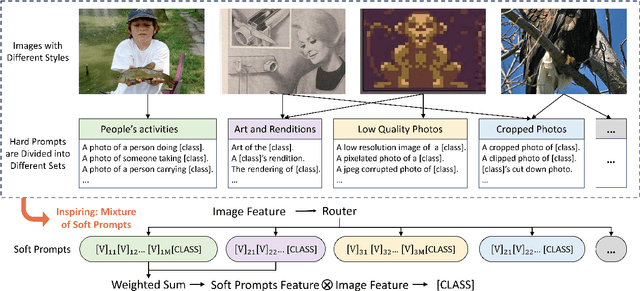
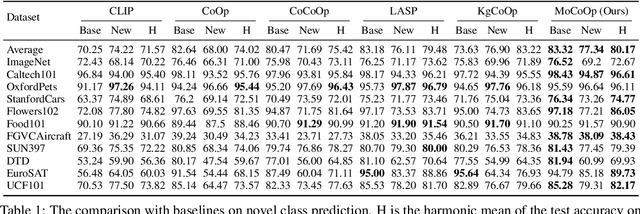
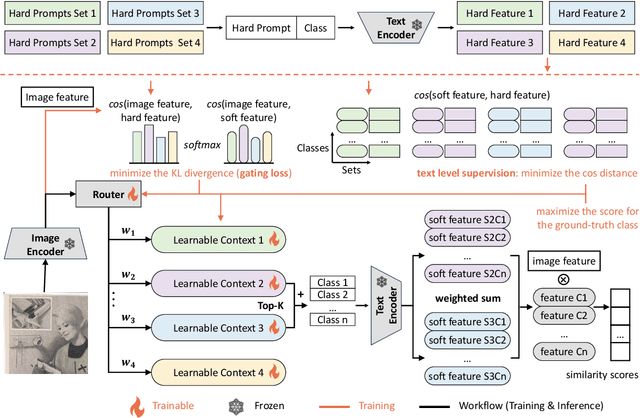

Abstract:As powerful pre-trained vision-language models (VLMs) like CLIP gain prominence, numerous studies have attempted to combine VLMs for downstream tasks. Among these, prompt learning has been validated as an effective method for adapting to new tasks, which only requiring a small number of parameters. However, current prompt learning methods face two challenges: first, a single soft prompt struggles to capture the diverse styles and patterns within a dataset; second, fine-tuning soft prompts is prone to overfitting. To address these challenges, we propose a mixture of soft prompt learning method incorporating a routing module. This module is able to capture a dataset's varied styles and dynamically selects the most suitable prompts for each instance. Additionally, we introduce a novel gating mechanism to ensure the router selects prompts based on their similarity to hard prompt templates, which both retaining knowledge from hard prompts and improving selection accuracy. We also implement semantically grouped text-level supervision, initializing each soft prompt with the token embeddings of manually designed templates from its group and applied a contrastive loss between the resulted text feature and hard prompt encoded text feature. This supervision ensures that the text features derived from soft prompts remain close to those from their corresponding hard prompts, preserving initial knowledge and mitigating overfitting. Our method has been validated on 11 datasets, demonstrating evident improvements in few-shot learning, domain generalization, and base-to-new generalization scenarios compared to existing baselines. The code will be available at \url{https://anonymous.4open.science/r/mocoop-6387}
General-purpose Dataflow Model with Neuromorphic Primitives
Aug 02, 2024



Abstract:Neuromorphic computing exhibits great potential to provide high-performance benefits in various applications beyond neural networks. However, a general-purpose program execution model that aligns with the features of neuromorphic computing is required to bridge the gap between program versatility and neuromorphic hardware efficiency. The dataflow model offers a potential solution, but it faces high graph complexity and incompatibility with neuromorphic hardware when dealing with control flow programs, which decreases the programmability and performance. Here, we present a dataflow model tailored for neuromorphic hardware, called neuromorphic dataflow, which provides a compact, concise, and neuromorphic-compatible program representation for control logic. The neuromorphic dataflow introduces "when" and "where" primitives, which restructure the view of control. The neuromorphic dataflow embeds these primitives in the dataflow schema with the plasticity inherited from the spiking algorithms. Our method enables the deployment of general-purpose programs on neuromorphic hardware with both programmability and plasticity, while fully utilizing the hardware's potential.
Solution-oriented Agent-based Models Generation with Verifier-assisted Iterative In-context Learning
Feb 04, 2024Abstract:Agent-based models (ABMs) stand as an essential paradigm for proposing and validating hypothetical solutions or policies aimed at addressing challenges posed by complex systems and achieving various objectives. This process demands labor-intensive endeavors and multidisciplinary expertise. Large language models (LLMs) encapsulating cross-domain knowledge and programming proficiency could potentially alleviate the difficulty of this process. However, LLMs excel in handling sequential information, making it challenging for analyzing the intricate interactions and nonlinear dynamics inherent in ABMs. Additionally, due to the lack of self-evaluation capability of LLMs, relying solely on LLMs is insufficient to effectively accomplish this process. In this paper, we present SAGE, a general solution-oriented ABM generation framework designed for automatic modeling and generating solutions for targeted problems. Unlike approaches reliant on expert handcrafting or resource-intensive neural network training, SAGE establishes a verifier-assisted iterative in-context learning process employing large language models (LLMs) to leverages their inherent cross-domain knowledge for tackling intricate demands from diverse domain scenarios. In SAGE, we introduce an semi-structured conceptual representation expliciting the intricate structures of ABMs and an objective representation to guide LLMs in modeling scenarios and proposing hypothetical solutions through in-context learning. To ensure the model executability and solution feasibility, SAGE devises a two-level verifier with chain-of-thought prompting tailored to the complex interactions and non-linear dynamics of ABMs, driving the iterative generation optimization. Moreover, we construct an evaluation dataset of solution-oriented ABMs from open sources.It contains practical models across various domains.
General Automatic Solution Generation of Social Problems
Jan 25, 2024Abstract:Given the escalating intricacy and multifaceted nature of contemporary social systems, manually generating solutions to address pertinent social issues has become a formidable task. In response to this challenge, the rapid development of artificial intelligence has spurred the exploration of computational methodologies aimed at automatically generating solutions. However, current methods for auto-generation of solutions mainly concentrate on local social regulations that pertain to specific scenarios. Here, we report an automatic social operating system (ASOS) designed for general social solution generation, which is built upon agent-based models, enabling both global and local analyses and regulations of social problems across spatial and temporal dimensions. ASOS adopts a hypergraph with extensible social semantics for a comprehensive and structured representation of social dynamics. It also incorporates a generalized protocol for standardized hypergraph operations and a symbolic hybrid framework that delivers interpretable solutions, yielding a balance between regulatory efficacy and function viability. To demonstrate the effectiveness of ASOS, we apply it to the domain of averting extreme events within international oil futures markets. By generating a new trading role supplemented by new mechanisms, ASOS can adeptly discern precarious market conditions and make front-running interventions for non-profit purposes. This study demonstrates that ASOS provides an efficient and systematic approach for generating solutions for enhancing our society.
Dance of SNN and ANN: Solving binding problem by combining spike timing and reconstructive attention
Nov 11, 2022



Abstract:The binding problem is one of the fundamental challenges that prevent the artificial neural network (ANNs) from a compositional understanding of the world like human perception, because disentangled and distributed representations of generative factors can interfere and lead to ambiguity when complex data with multiple objects are presented. In this paper, we propose a brain-inspired hybrid neural network (HNN) that introduces temporal binding theory originated from neuroscience into ANNs by integrating spike timing dynamics (via spiking neural networks, SNNs) with reconstructive attention (by ANNs). Spike timing provides an additional dimension for grouping, while reconstructive feedback coordinates the spikes into temporal coherent states. Through iterative interaction of ANN and SNN, the model continuously binds multiple objects at alternative synchronous firing times in the SNN coding space. The effectiveness of the model is evaluated on synthetic datasets of binary images. By visualization and analysis, we demonstrate that the binding is explainable, soft, flexible, and hierarchical. Notably, the model is trained on single object datasets without explicit supervision on grouping, but successfully binds multiple objects on test datasets, showing its compositional generalization capability. Further results show its binding ability in dynamic situations.
Adversarial Feature Stacking for Accurate and Robust Predictions
Mar 24, 2021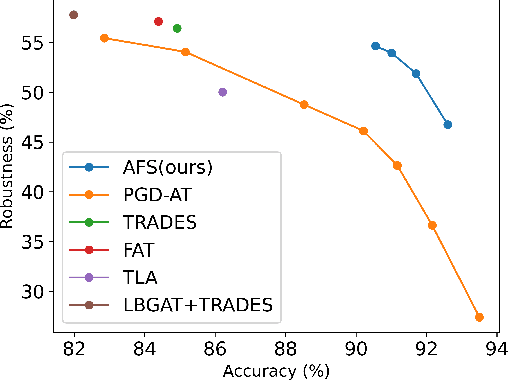
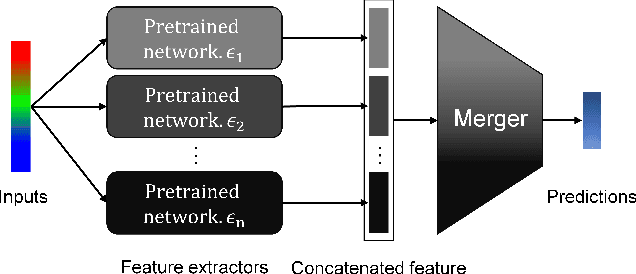

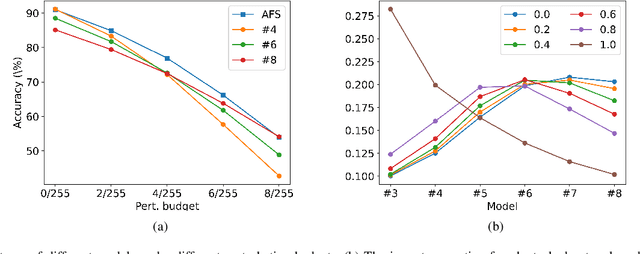
Abstract:Deep Neural Networks (DNNs) have achieved remarkable performance on a variety of applications but are extremely vulnerable to adversarial perturbation. To address this issue, various defense methods have been proposed to enhance model robustness. Unfortunately, the most representative and promising methods, such as adversarial training and its variants, usually degrade model accuracy on benign samples, limiting practical utility. This indicates that it is difficult to extract both robust and accurate features using a single network under certain conditions, such as limited training data, resulting in a trade-off between accuracy and robustness. To tackle this problem, we propose an Adversarial Feature Stacking (AFS) model that can jointly take advantage of features with varied levels of robustness and accuracy, thus significantly alleviating the aforementioned trade-off. Specifically, we adopt multiple networks adversarially trained with different perturbation budgets to extract either more robust features or more accurate features. These features are then fused by a learnable merger to give final predictions. We evaluate the AFS model on CIFAR-10 and CIFAR-100 datasets with strong adaptive attack methods, which significantly advances the state-of-the-art in terms of the trade-off. Without extra training data, the AFS model achieves a benign accuracy improvement of 6% on CIFAR-10 and 9% on CIFAR-100 with comparable or even stronger robustness than the state-of-the-art adversarial training methods. This work demonstrates the feasibility to obtain both accurate and robust models under the circumstances of limited training data.
 Add to Chrome
Add to Chrome Add to Firefox
Add to Firefox Add to Edge
Add to Edge